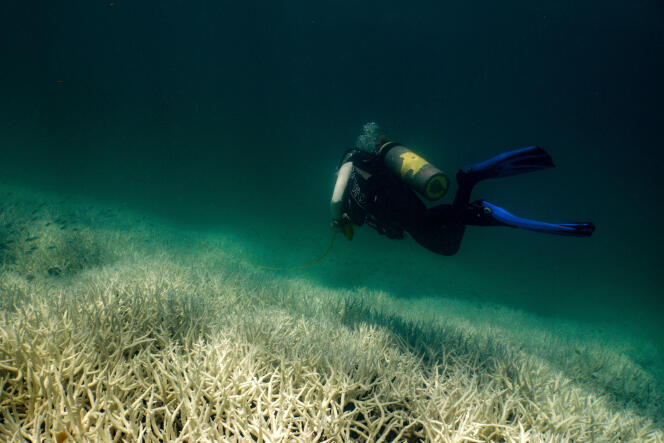


Unsurprisingly, the Great Barrier Reef is facing the worst-case scenario. Not only has climate change triggered a deleterious cycle, but it is also accelerating. On Friday, March 8, the Australian authorities announced that, for the seventh time in twenty-six years, a process of "mass bleaching" was affecting the world's largest living structure, located off the northeast coast of the island continent. This marks the fifth occurrence in eight years.
According to aerial surveys conducted over three hundred reefs covering two-thirds of the marine park, the damages appear to be significant. "The problem with the current episode is its extent. It seems to be affecting the whole of the Great Barrier Reef, including the southern part, which has been affected less often and where the reefs, in relatively good condition, are home to a high proportion of endemic species," explained Andrew Baird, a marine ecology researcher at James Cook University, who fears that this new bleaching event will prove to be "of unprecedented proportions." Studies are underway to determine its exact extent and depth. Its severity will also depend on the evolution of ocean temperatures over the coming weeks.
Bleaching is a phenomenon of coral decline caused by rising surface water temperatures, resulting in the expulsion of symbiotic algae that give coral its vibrant color. If water stress diminishes quickly, marine organisms can recover. Otherwise, they begin to die off. Some are more resilient than others.
Since the first major episode in 1998, the ecosystem covering about the size of Italy has been affected in 2002 and then, at an accelerated frequency from 2016, with massive bleaching events in 2016, 2017, 2020, 2022, and now 2024. In total, 98% of its 3,000 individual reefs have been impacted – home to some 1,500 species of fish.
"The higher the frequency of episodes, the less time corals have to recover, and the more fragile they become," explained Baird. "This frequency is likely to become annual in the decades to come. And obviously, the Great Barrier Reef, as we know it, would not survive such pressure," added the scientist. In the Townsville area, where he's based, he has already noticed a change in species composition, with more underwater grasses and fewer massive coral colonies.
In the summer of 2022, scientists were also alarmed to find that the structure was experiencing bleaching for the first time in a La Niña year, a climatic phenomenon usually characterized by abnormally low water temperatures on the southern coasts. On July 4, 2023, when the World Meteorological Organization announced the return of El Niño – synonymous with rising temperatures in the antipodes – they warned that the Great Barrier Reef was heading for a period of very high risk, something which materialized over the summer in unprecedented levels of thermal stress in the Central and Southern regions.
You have 30.59% of this article left to read. The rest is for subscribers only.
